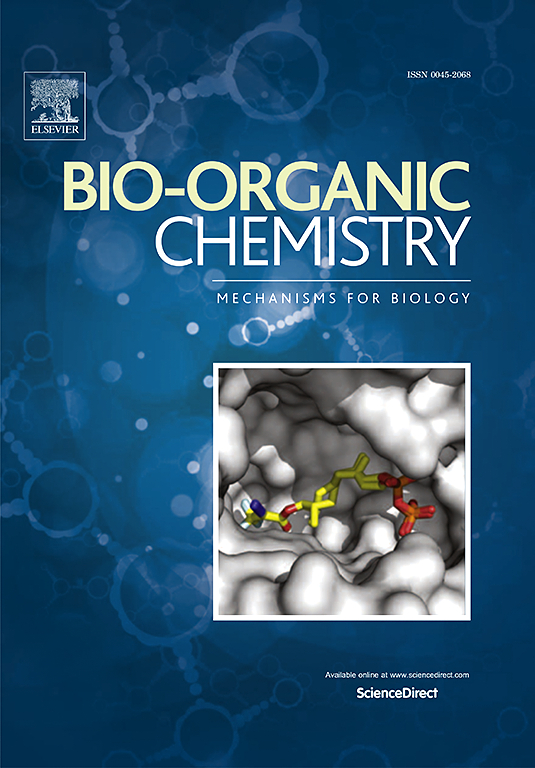他莫昔芬衍生的全氟烷基烯烃治疗乳腺癌的研究
IF 4.5
2区 医学
Q1 BIOCHEMISTRY & MOLECULAR BIOLOGY
引用次数: 0
摘要
自1998年以来,雌激素反应性乳腺癌一直使用他莫昔芬治疗,但选择性有限和新出现的耐药性等挑战仍然是改善治疗结果的重大障碍。近年来,由于其独特的性质,氟原子在潜在药物结构中的掺入变得越来越重要。全氟烷基链以其化学惰性和靶向雌激素的能力而闻名,为提高治疗效果提供了有希望的修改。在这项研究中,我们评估了21个全氟烷基他莫昔芬衍生物的生物活性,这些衍生物是在温和的条件下合成的,具有高立体选择性。其中7种化合物对雌激素受体阳性乳腺癌细胞(MCF-7)表现出优异的细胞毒性和选择性活性,IC50值为10.68-18.18 nM,而标准治疗中使用的4-羟他莫昔芬的IC50值为29.41 nM。在ESR1(雌激素受体基因)siRNA敲低的支持下,初步的作用机制研究表明,这些化合物的作用机制与他莫昔芬相似,进一步证实了它们作为雌激素受体阳性乳腺癌的下一代治疗剂的潜力。本文章由计算机程序翻译,如有差异,请以英文原文为准。

Study of tamoxifen derived perfluoroalkylated olefins in breast cancer treatment
Estrogen-responsive breast cancer has been treated with tamoxifen since 1998, yet challenges such as limited selectivity and emerging resistance remain significant hurdles to improving therapeutic outcomes. In recent years, the incorporation of fluorine atoms in the structure of potential drugs has gained importance due to their unique properties. Perfluoroalkyl chains, known for their chemical inertness and ability to target estrogen, offer promising modifications to improve treatment efficacy. In this study, we evaluated the biological activity of 21 perfluoroalkylated tamoxifen derivatives, synthesized under mild conditions with high stereoselectivity. Seven of these compounds exhibited superior cytotoxic and selectivity activity against estrogen receptor-positive breast cancer cells (MCF-7), with IC50 values of 10.68–18.18 nM compared to 29.41 nM for 4-hydroxytamoxifen, which is used in standard therapy. Preliminary mechanism-of-action studies, supported by siRNA knockdown of ESR1 (the estrogen receptor gene), revealed that the compounds act through a similar mechanism to tamoxifen, further confirming their potential as next-generation therapeutic agents for estrogen receptor-positive breast cancer.
求助全文
通过发布文献求助,成功后即可免费获取论文全文。
去求助
来源期刊

Bioorganic Chemistry
生物-生化与分子生物学
CiteScore
9.70
自引率
3.90%
发文量
679
审稿时长
31 days
期刊介绍:
Bioorganic Chemistry publishes research that addresses biological questions at the molecular level, using organic chemistry and principles of physical organic chemistry. The scope of the journal covers a range of topics at the organic chemistry-biology interface, including: enzyme catalysis, biotransformation and enzyme inhibition; nucleic acids chemistry; medicinal chemistry; natural product chemistry, natural product synthesis and natural product biosynthesis; antimicrobial agents; lipid and peptide chemistry; biophysical chemistry; biological probes; bio-orthogonal chemistry and biomimetic chemistry.
For manuscripts dealing with synthetic bioactive compounds, the Journal requires that the molecular target of the compounds described must be known, and must be demonstrated experimentally in the manuscript. For studies involving natural products, if the molecular target is unknown, some data beyond simple cell-based toxicity studies to provide insight into the mechanism of action is required. Studies supported by molecular docking are welcome, but must be supported by experimental data. The Journal does not consider manuscripts that are purely theoretical or computational in nature.
The Journal publishes regular articles, short communications and reviews. Reviews are normally invited by Editors or Editorial Board members. Authors of unsolicited reviews should first contact an Editor or Editorial Board member to determine whether the proposed article is within the scope of the Journal.
 求助内容:
求助内容: 应助结果提醒方式:
应助结果提醒方式:


